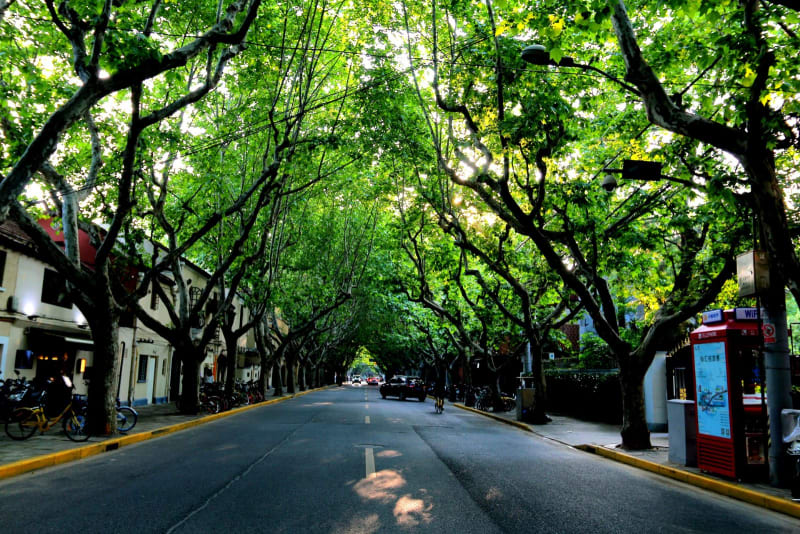Without getting into too many details, what is referred to today as the French Concession is really a land grant of 66 hectares made by the acting governor of Shanghai Lin Kouei for a French Settlement in 1849. This occurred in the backdrop of what is referred to as the First Opium War that saw the British Empire and Qing Dynasty forces have a series of military engagements over conflicting viewpoints on diplomatic relations, trade, and the administration of justice in China. While the intricacies and morality of the may be interesting from an academic point of view, the simple truth is that Britain strong-armed another nation into an unfair trade deal.

The main component of that deal was a land grant concession for the British that eventually merged with the American Concession to become the International Settlement. The newly formed district was effectively three times the size of the French Concession. The canal that used to run where Yan’an Road now bisects the city into north and south, marked the boundary between the French Concession to the south and the International Settlement to the north of the canal all the way from the Huangpu River to the east to the edge of the settlements to the west.
An important thing to know about the borders of expat areas in most cities around the world is that they evolve according to the current zeitgeist (the defining current mood at any point in history) of the expats in those areas. In the case of the French Concession, what has been, is currently, and will be in the future considered the French Concession changes over time as residents shift according to economic and regulatory growth of the area. What is now Xujiahui was a part of the French Concession at one point as was the area south of Yan An Road along the Huangpu. Now the whole riverside area is simply known as the Bund.
Today the center piece of the French Concession is Huai Hai Road with the corner of Shaanxi Road and Huai Hai Road being considered the nexus. The walk from the corner of Shaanxi Road east to Huangpi Road is boutique and luxury fashion at it’s finest in China – essentially China’s 5th Avenue.
To the south and north of Huai Hai past Huangpi Road near the Huangpu River, large swathes of decaying Shikumen lane houses have been demolished as the redevelopment of the entire South Bund area continues in parallel with the massive development of the Pudong side of the River south of Lujiazui. For the most part however, what is now considered the French Concession is relatively stable with Yan An bordering the north, Zhaojiabang Road to the south, the North-South Elevated Highway to the east and Huashan Road to the West. On the west side of Huashan Road, the Xinhua Road Residential District and the area surrounding Jiaotong University are also considered part of the French Concession.
The feel
A defining characteristic of the Former French Concession is the French planes that often line both sides of the streets. Known locally as French maples due to the similar shape of the leaves, these trees grow to touch each other in the middle of the street during the hottest time of the year creating and other worldly feel to many streets. The French Maples also offer respite from the brutal Shanghai summer sun and change color in the fall before losing their leaves for the winter.
Housing options
The most common properties to rent in the area are lane house apartments and whole lane houses that have been restored to multi-floor single-family dwellings. Luxury serviced apartments and normal apartments are also popular and all choices are a level up in price compared to the other areas of the city. There are many unusual layouts in the renovated lane houses up for offer at any one time, as the gentrification of the area has been very complicated from a regulatory standpoint.
While elderly residents of the area don’t actually own the apartments they live in, they have the right of residence for life. In China, this right of residence and the system that surrounds it is generally sacrosanct. Residents, however, may choose to move their place of residence in order to receive and live in a brand new apartment on the fringes of the city if provided by a developer, for example. That developer likely owns the new complex and wants to do luxury development.
Whether or not you agree with the gentrification of what little remains of old Shanghai, the irregular process just means there are a wide variety of interesting small apartments dotted across the whole area as there are “nail houses” – the Chinese term for properties that won’t sell out to developers.
That same irregularity in the entire neighborhood is what makes it perfect for boutique shops and restaurants of which the entire area is brimming. There is a constant push back and forth in the whole area between business and residents – particularly business that involves late night partying and the noise that usually results when the party expands onto the street after dark.
Transportation links to the whole area are excellent. You are never more than a 10-15 minute walk to Metro Station and taxis are abundant. Rush-hour gridlock is common on the narrow streets so most residents use the Metro.
Most international schools have buses that service the area and there are a variety of options for nursery schools and kindergartens throughout the neighborhood.
Luwan Sports Center is the backbone of sports facilities in the area and had pretty much everything and anything you would want. The facilities are well-maintained, clean and fees are minimal. Private gyms and yoga studios dot the area
All in all, the Former French Concession is delightfully warm and inviting. It has some of the best eating and drinking scene in China, the most unique places to call home in Shanghai and some of the best shopping in the city at your fingertips.





